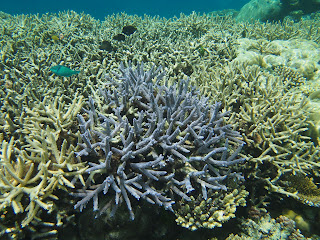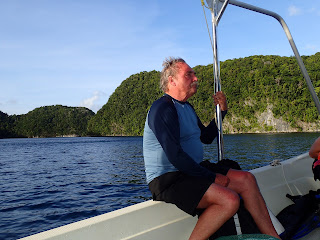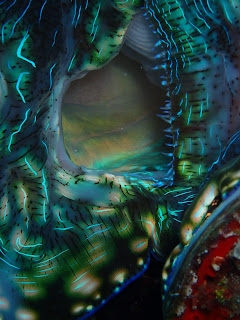Frithjof C. Küpper and Eleni Kytinou
We have recently completed a two-week expedition to Palau (Micronesia,
tropical western Pacific), following 4 days visiting Frithjof’s friends in
Chiba and Tokyo (Japan). The objectives were
(1)
To
conduct some preliminary work investigating the photonics of the algal-clam
symbiosis the planet’s largest molluscs, Giant Clams (Tridacna gigas);
(2)
To
assess Palau’s cryptic macroalgal diversity using the Germling Emergence Method[1],
developed by Akira Peters in Roscoff – this consists of collecting
substratum samples during dives using sterile tubes, which are then
subsequently incubated under suitable culturing conditions in the lab allowing
to isolate any developing algal outgrowth into unialgal or even clonal
cultures. On other occasions of our expeditions since 2007, this has resulted
in detecting numerous new records and, in some cases, species new to science
(e.g. from Malaysia, the Arctic and Antarctic, Easter Island, Cyprus and
Greece).
(3)
To
conduct visual surveys along transects in order to study the food web structure
within the framework of Eleni’s PhD research.
On March 30, Frithjof flew from Aberdeen to Tokyo-Narita and spent the
next 2 days with Yusai Itoh and Tatsuo Kaiho. Yusai and Frithjof had been
postdocs together in Alison Butler’s lab at UC Santa Barbara, while he had collaborated with
Tatsuo on iodine-related research[i].
Eleni followed 2 days later – Tatsuo and Frithjof were waiting for her at
Narita Airport, and after a quick visit to Tatsuo’s beautiful house and garden
in Chiba, we were met in Tokyo by Mikako Inada (Saito), a documentary film maker specialized in penguins whom Frithjof had befriended in the
Falkland Islands back in 2010. Mika was an excellent guide – we spent the first
evening dining together in Ginza. The night was very short – we got up at about
1.30 am for being in time for the tuna auction at the Tsukiji fish market. We
had to wait for around 3 h until we were let into the auction. Outside the
auction hall was a frenzy of trucks, forklifts and traders rushing around.
Inside were around 1,000 deep-frozen tunas (mostly Bluefin) from around the
world. Within around half an hour, the auction was over – a typical price for a
Bluefin tuna was around US$ 10,000. This auction is held 3 times weekly. No
surprise fewer and fewer top predators are left in the world’s seas – as even
the tuna trader, who gave an English-language introduction to us prior to the
event, had to admit. After the auction, we headed back to our hotel for another
2 h of much-needed sleep before a day of sightseeing around Tokyo – the
Buddhist temples and Shinto shrines of Asakusa, and then a cruise down the
Sumida River to the Odaiba district, which is built on reclaimed land in Tokyo
Bay. All this in beautiful spring weather – it was Sakura (cherry blossom)
season! In the evening, we saw the illuminated cherry blossom around the
Imperial Palace, followed by our farewell dinner from Mika and Tatsuo.
The next day, we re-visited the Tsukiji fish market – this time the
Inner and Outer Market. Pretty much everything in terms of marine animal
diversity on the planet is on sale here. We then visited Yasukuni, the Shinto
shrine where Japan’s war dead area honored (the shrine has repeatedly caused
controversy with neighboring Asian countries, since the enshrined include
convicted WW II war criminals – especially when it was visited by Japanese
leading politicians). After a bit of rest, we headed to Narita Airport, where
we met up with Dan and Aileen Morse, who had been traveling around
Japan for around a week – Frithjof had been friends with Dan and Aileen ever
since they met in Roscoff in late summer 1999, when he helped them collect the
red alga Asparagopsis by snorkeling. Dan,
Aileen and Frithjof had been discussing about a trip to Palau since around 2010
– Dan and Aileen had been working in Palau since the 1980s, almost a decade
before this former US Territory became independent in 1994. They had been
trying to develop a project (and, critically, to find grant funding) for a
project on the mollusk-algal symbiosis since 2015. The trip finally came to
reality when during Frithjof’s latest trip to California in December 2016, he
visited them in Santa Barbara and they decided during their first evening
together “now or never – we live only once – let’s go”.
And here we were, at Tokyo’s Narita Airport, boarding a flight to Palau…
after 5 hours in the air, we landed at the small island country’s only airport
about 1 am. A driver waited for us and took us to our accommodation.
After sleeping in the next morning to catch up on missed sleep after 3
short nights, we met at the Aquarium of PICRC (Palau International Coral Reef
Center) and discussed plans and arrangements. Travelling independently, we were
joined by Neal Hooker, long-time group member of Dan’s and Aileen’s lab (and
friends with Frithjof since December 2000), Dan’s cousin Michael Gochfeld, an environmental toxicologist and
ornithologis and his wife Joanna Burger, ornithologist and behavioral ecologist at
Rutgers University, as well as Dan’s former grad student, Danny deMartini and
his wife Caitlin.
Since everybody was still quite tired, we decided not to go diving or
snorkeling, but had an excursion inland on Palau’s big island, Babeldaob. We
explored the Ngardok Nature Reserve and were fascinated by the abundance of
pitcher plants, clubmosses (Lycopodium
sp.) and orchids – with large fruit bats flying above us. A bit further on, we
reached Palau’s parliament in its capital, Melekeok (which consists only of the
government buildings, nothing else), via a lengthy dirt track through the
jungle – we figured later that this was due to poor signposting, there was
indeed a more convenient, paved road… The parliament and other government
buildings, with Greek columns and neoclassicist architecture, were modelled
upon the US Capitol in Washington DC. We were particularly amused by depictions
of the Money Bird (Delerrok) on the walls of the Palau capitol. Back in the
capital, Koror, a magnificent Indian dinner at the Taj followed.
The next day, we got into the sea! Dan had arranged for a boat with
skipper from PICRC, who took us to one of Palau’s many spectacular marine
lakes. On the way, we stopped at a WW II Japanese gun emplacement and a resting
site of sea snakes (which Dan had found during a previous trip) – but the
snakes were obviously away (at sea). (They subsequently made appearances for
Joanna – seeing one stretched-out sunning at full length, of nearly 2 meters!)
and for Dan – when they wee apparently mating.) The marine lake was mostly surrounded by one
of the famous Rock Islands, except for a small exit channel to the surrounding
sea. Indeed, a very unique ecosystem – a coral reef community in the marine
lake, and dense tropical rain forest on the Rock Island around it. The input of
terrestrial biomass, wood and leaf litter, combined with very tranquil waters
created very special conditions. We spent several hours snorkeling and were
totally left in awe. After lunch on the boat, we went to another marine lake
site closer to Koror and PICRC, for another round of snorkeling with a large
abundance of fish and many Tridacna
crocea (boring clams) in coral blocks and lime stone in shallow waters.
Giant (Tridacna gigas) and boring
clams (T. crocea) have an amazing
diversity of brilliantly colored patterns. The origins and functions of these
colors has been a very successful research area in Dan’s lab for years. These
colors are not due to pigments, but entirely due to the reflective properties
of membranes in the clam mantle tissue. The greater proportion of the light,
however, is not reflected, but directed (via a process called Mie forward
scattering) deeper into the clam tissue where it exposes symbiotic microalgae with photosynthetically
active light.
The next day, we explored two more sites in the southern, outer lagoon
by snorkeling – Ulong Channel and south of Ulong Island. The reefs
that we encountered there and very much throughout the entire trip were in
excellent shape, with close to 100% cover by healthy corals and no trace of
coral bleaching.
10 days of intense scuba diving followed. Some of the sites visited have
a mythical reputation among scuba divers throughout the world – including Blue
Corner and Blue Hole. Again, the large diversity of marine life in nearly
pristine coral reef systems was stunning. Eleni managed to conduct a large
number of transects for her PhD, and Frithjof collected numerous substratum
samples, which are now being incubated for algal isolation work by Akira. Particularly
useful for Eleni’s studies was the large abundance of top predators, testimony
to the absence of intense fishing pressures
On several occasions, we came across traces of the dramatic events of
World War II in Palau – one day, we dived at a Japanese ship wreck west of
Babeldaob Island which had been sunk by American forces. On another occasion,
on an afternoon snorkeling and kayak excursion around Koror, we found the wreck
of a Japanese Zero fighter aircraft in very shallow water! Close to the one of
the entrance channels towards PICRC and Koror, we came past a Japanese gun
emplacement. Some of our dive sites (e.g. Blue Corner) were close to Peleliu
Island, which was heavily fought over between Japanese forces and U.S. Marines,
resulting in one of the worst losses of life (> 20,000) on a single island
in the Pacific War. Given what a peaceful place Palau now is, it is hard to
imagine what occurred in and around these islands 73 years ago.
Thank you, Dan, for organizing such a marvelous expedition, and thanks
to you, Aileen, Neal, Danny, Caitlin, Joanna and Mike, for being such a
pleasant team! We will be working hard on the follow-up work in the lab back home
to make it a success.
[1] Peters AF, Couceiro L, Tsiamis K, Küpper
FC, Valero M, 2015: Barcoding of cryptic stages of marine brown algae
isolated from incubated substratum reveals high diversity in Acinetosporaceae
(Ectocarpales).- Cryptogamie-Algologie 36(1), 3-29
(Click on the images for a full-screen, high-resolution view.
You can browse by using the cursor buttons.)
You can browse by using the cursor buttons.)
Frozen lakes and taiga landscape in northern Russia near Arkhangelsk
Northern Lights in the Russian Arctic on the way from Amsterdam to Tokyo,
roughly between Novaya Zemlya and Norilsk
roughly between Novaya Zemlya and Norilsk
Narita-San, Shingon Buddhist temple
Lunch with Yusai in Narita - Kampai!
One
of Chiba's landmarks, the suspended monorail (for those who know the
Wuppertaler Schwebebahn in Germany, the parallel is obvious!)
Chiba's reconstructed castle
One of Chiba's pretty, artistic sewer lids
Cherry blossom in Tatsuo Kaiho's garden, Chiba
Tuna auction, Tsukiji Fish Market, Tokyo (foto: Eleni Kytinou)
Tuna auction, Tsukiji Fish Market, Tokyo (foto: Eleni Kytinou)
Cruise on the Sumida River from Asakusa to Odaiba, Tokyo
Evening walk to watch the cherry blossom (Sakura) at the Imperial Palace, Tokyo
Yasukuni Shrine, Tokyo
After our overnight flight from Tokyo to Palau: First morning at PICRC, discussing plans
Orchid in the interior of Babeldaob Island
The Palauan government building, Melekeok
Japanese WWII gun emplacement at the entrance to Koror Harbor
Entrance passage to a marine lake in one of Palau's Rock Islands (foto: Eleni Kytinou)
Marine lake in one of Palau's Rock Islands (foto: Eleni Kytinou)
Marine lake in one of Palau's Rock Islands
- note the large amount of wood from the surrounding tropical rainforest
- note the large amount of wood from the surrounding tropical rainforest
Marine lake in one of Palau's Rock Islands (foto: Eleni Kytinou)
Marine lake in one of Palau's Rock Islands (foto: Eleni Kytinou)
Crown-of-thorns starfish, marine lake in one of Palau's Rock Islands (foto: Eleni Kytinou)
Jay, our skipper, driving one of the PICRC boats (funded by Japanese development aid) (foto: Eleni Kytinou)
Fusiliers (foto: Eleni Kytinou)
The endangered humphead wrasse (Cheilinus undulatus) (foto: Eleni Kytinou)
Fusiliers surrounding us (foto: Eleni Kytinou)
Boring clam (Tridacna crocea)
Sponge
Sunset at PICRC, Koror
Intact coral reef, Ulong Channel
Intact coral reef, Ulong Channel
Giant clam (Tridacna gigas) (foto: Eleni Kytinou)
Details of giant clam (Tridacna gigas) (foto: Eleni Kytinou)
Hawksbill turtle (Eretmochelys imbricata)
Aileen snorkeling above coral reef, Ulong Channel (foto: Eleni Kytinou)
Rainforest, Ulong Island
Barringtonia asiatica, a tree with fruit containing a potent neurotoxin
(used for traditional fishing in some Pacific islands), Ulong Island
(used for traditional fishing in some Pacific islands), Ulong Island
Ulong Island
Palauan Rock Island scenery
Needlefish or halfbeak
Experiment by scientists based at PICRC
Sponge
These corals must be centuries old!
Neal on the PICRC boat
About half of our team on the PICRC boat
Return to PICRC
Traditional Palauan long house, Palau National Museum, Koror
Traditional Palauan long house, Palau National Museum, Koror
Traditional Palauan long house, Palau National Museum, Koror
Seagrass meadow during our nighttime snorkeling excursion
Eleni snorkeling at night
Christmas tree worm in seagrass meadow
Ascidians on seagrass leaves (foto: Eleni Kytinou)
Fruit bat above the rainforest in Babeldaob at dusk
The number and size of pitcher plants we encountered was amazing - like so much else!
Former mining area in the interior of Babeldaob
Trail in the rainforest, Babeldaob
Sea snail in seagrass meadow at night (foto: Eleni Kytinou)
Siganus sp. (Spinefoot), a herbivorous fish, in seagrass meadow (foto: Eleni Kytinou)
Pneumatophores of mangrove trees, east coast of Babeldaob
Pneumatophores of mangrove trees, east coast of Babeldaob
- with the capitol of Melekeok in the background
Hike to the Ngardmau Water Fall, Babeldaob
River downstream of the Ngardmau Water Fall, Babeldaob
Ngardmau Water Fall, Babeldaob
Fish eggs in pool beneath the the Ngardmau Water Fall, Babeldaob (foto: Eleni Kytinou)
Ngardmau Water Fall, Babeldaob (foto: Eleni Kytinou)
Fish in pool beneath the the Ngardmau Water Fall, Babeldaob (foto: Eleni Kytinou)
Starfish at night in seagrass meadow near Koror (foto: Eleni Kytinou)
Christmas tree worm & coral at night in seagrass meadow near Koror (foto: Eleni Kytinou)
Eleni diving at Blue Corner
Collecting a susbtratum sample
Eleni diving at Blue Corner
Dropoff at Blue Corner...looking up
Dropoff at Blue Corner...looking down over the cliff edge
(Translation from Greek:) "Do your work - it's a good spot" - "Let's go to 10 m and start"
Eleni laying her transect rope at 10 m depth
Ascidians
(foto: Eleni Kytinou)
(foto: Eleni Kytinou)
(foto: Eleni Kytinou)
The typical rainstorm at about 5 pm!
Eleni changing scuba tank before the rainstorm hit us
One of our dinner venues in Koror
Free-swimming nudibranch, seen while snorkeling at night (foto: Eleni Kytinou)
Skull of a saltwater crocodile, found while snorkeling at night
German Channel
On the PICRC boat
Green turtle (Chelonia mydas) sleeping (foto: Eleni Kytinou)
Outer reef slope
Eleni observing a grey reef shark (Carcharhinus amblyrhynchos) - Bue Corner
Grey reef shark (Carcharhinus amblyrhynchos) (foto: Eleni Kytinou) - Blue Corner
Eleni with the skull of the saltwater crocodile
which Danny had found while snorkeling with us a few nights before
which Danny had found while snorkeling with us a few nights before
Mud skipper in a mangrove on the east coast of Babeldaob
Thalassodendron, a seagrass in the lagoon on the east coast of Babeldaob
Preparing herbarium specimens at PICRC
(foto: Eleni Kytinou)
Details of a giant clam (foto: Eleni Kytinou)
Details of a giant clam (foto: Eleni Kytinou)
Subterranean passage linking the Milky Way marine lake to the surrounding sea
- at low tide (at high tide this is under water!)
- at low tide (at high tide this is under water!)
(foto: Eleni Kytinou)
The Milky Way marine lake
has its name from the fine-grain limestone particles suspended in its waters
has its name from the fine-grain limestone particles suspended in its waters
Eleni in the cockpit of a WWII Japanese Zero fighter (the most common Japanese WWII aircraft model, which was also used for attacking Pearl Harbor) in a shallow lagoon near Koror
Giant clam details (foto: Eleni Kytinou)
Frithjof diving at Japanese WWII ship wreck (foto: Eleni Kytinou)
Photoquadrat (foto: Eleni Kytinou)
Dinner in Koror
Blue Hole (foto: Eleni Kytinou)
Blue Hole (foto: Eleni Kytinou)
Eleni and Dan
Palau International Coral Reef Center, Koror (funded by Japanese development aid)
- our base for the 2 weeks in Palau
- our base for the 2 weeks in Palau
Visit to the Coral Reef Research Foundation, Koror
Visit to the Coral Reef Research Foundation, Koror
Visit to the Coral Reef Research Foundation, Koror



















































































































No comments:
Post a Comment